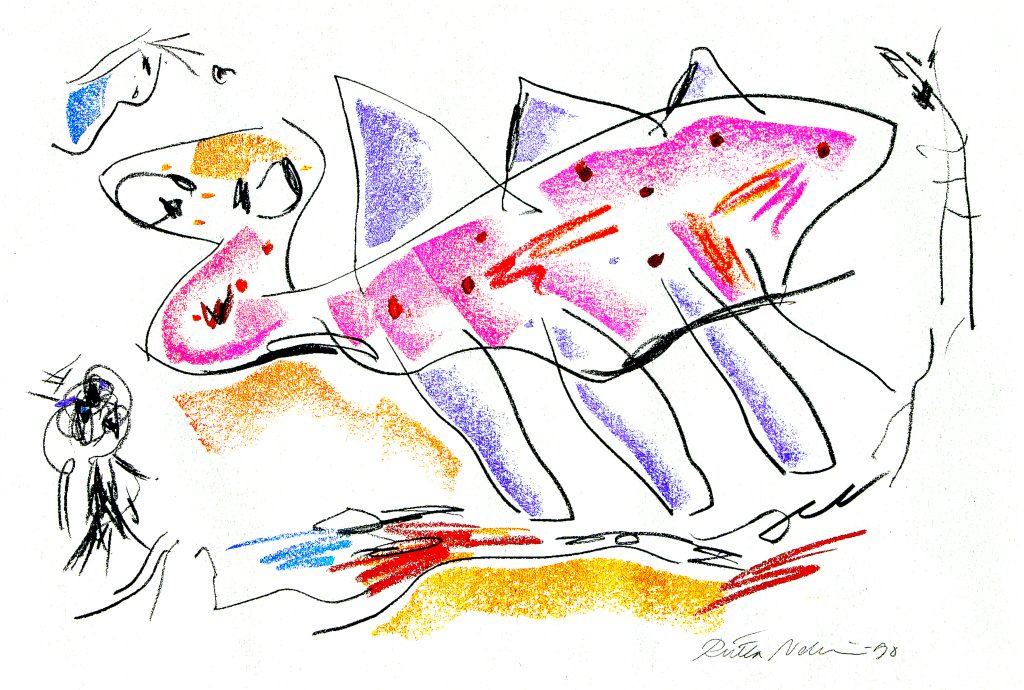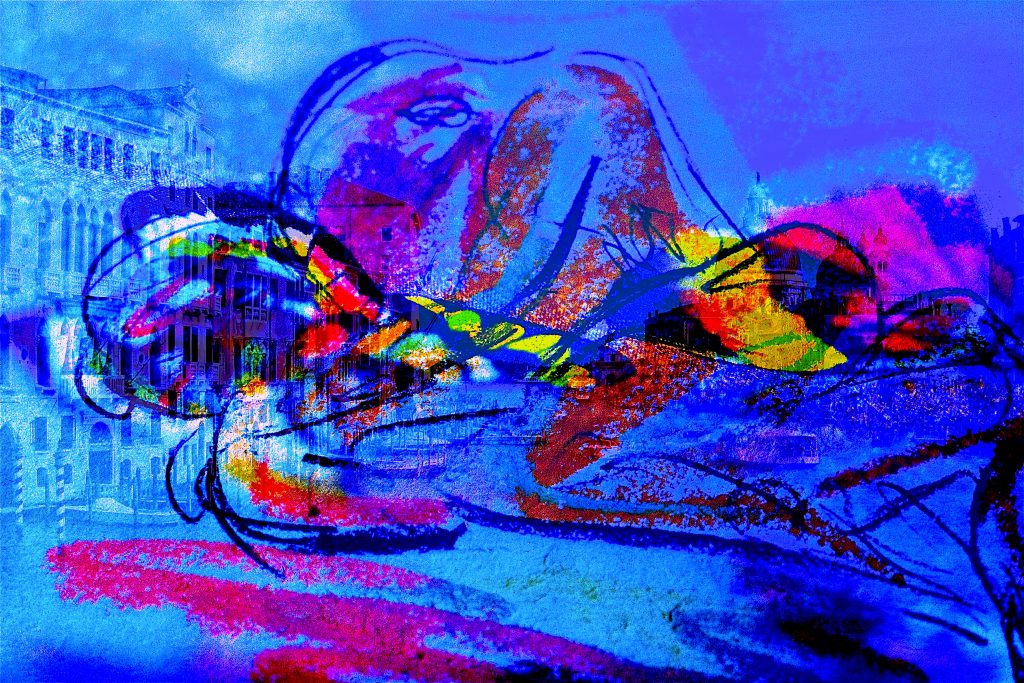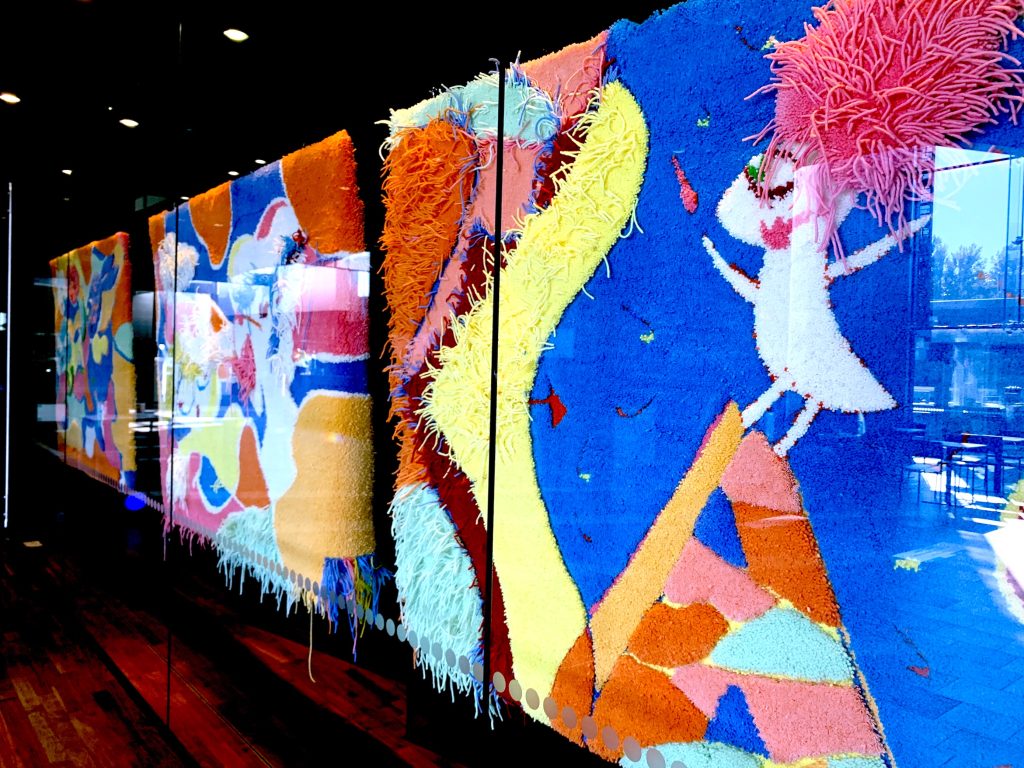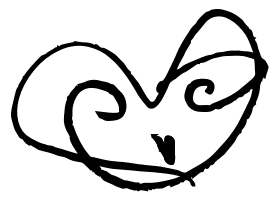“Just as life is given us to live, so dreams are given us to see – without any particular goal, without any particular interpretation. Rabbit.”
meet Elise
In Riitta Nelimarkka’s art, there often appears a recognizable character Elise. Sometimes Elise is a colorful, wooly creature, other times her charming image emerges on the surface of a photomontage or a painting.
RIITTA NELIMARKKA, WHO IS ELISE?
She is an alter ego, another self, a subconscious side character. The name derives from Beethoven’s ingenious, enduring piece Für Elise, which I played as a child, just like so many little girls. The alter ego was born when I needed a subject for my dissertation Self Portrait, Elise’s Dissertation – Variation of a Variation (2001).
Elise embodies everything that can be found within myself – multiple personas, dreamlike cognitive beings in different life situations. Elise, in all her diversity, is also an intuitive will, in a way a fighter, yet in her sharpness, she is most often subtle and precise. Through her, one can smuggle in quite wild secrets and strange humor. She is a doer who trusts her subconscious and looks back afterwards to see what has been done.
ELISE’S FACE INITIALLY RESEMBLES A HEART. WHAT IS THE SHAPE ACTUALLY BASED ON?
Her face took its form from what I consider to be the perfect shape of a grand piano. I’ve always been obsessed with grand pianos – this likely relates to my piano studies at the Sibelius Academy. In my latest book APOLLON & HELOISE (2023), the grand piano grew ears, and Elise transformed into the faun Heloise. This continues.
And the close resemblance to the heart design, a symbol of love, should not be excluded from Elise’s soul. Amor vincit omnia – Love conquers all, is tattooed in her overly thick almanac. : )
ELISE IS VERY EXPRESSIVE AND ALMOST CHAMELEON-LIKE. HOW DOES SHE START TO TAKE SHAPE IN YOUR ART?
Elise is constructed from the inside out, and her appearance reflects only a fraction of her inner world. In this Narnia-like state, outside of established norms, one can freely laugh, cry, and experience mixed emotions. Fall in love, be shocked, die.
In fact, the majority of Elise’s capacity is still untapped, almost entirely. Some micro-expressions in Elise’s drawings might reveal these unknown internal psychological and metaphysical canyons. NOSCE TE IPSUM – know yourself.
Elise’s face resembles the shape of a grand piano
moments
Artist Riitta Nelimarkka´s personal page on Circle Arts
Review by Myrina Tunberg Georgiou . Circle Foundation for the Arts Director.
Review by Myrina Tunberg Georgiou . Circle Foundation for the Arts Director.
HASSUNA EXHIBITION IN AN OLD STONE BARN
Riitta Nelimarkka’s exhibition Hassuna (engl. “As funny”) was showcased in an old stone barn at Art Pappila in Sastamala, Finland, during the summer of 2022. Art critic and non–fiction author Timo Valjakka gave the opening speech.
Riitta Nelimarkka’s exhibition Hassuna (engl. “As funny”) was showcased in an old stone barn at Art Pappila in Sastamala, Finland, during the summer of 2022. Art critic and non–fiction author Timo Valjakka gave the opening speech.
The exhibition’s name, Hassuna, referred to an ancient city in Mesopotamia (circa 6000 BCE). The name also captured the spirit of the enchantingly color–rich exhibition. “The more dire the state of life and the world in general, the more important it is to find joy. Otherwise, we face spiritual ruin,” Nelimarkka summarizes.
Art critic and non–fiction author Timo Valjakka gave the opening speech for the exhibition, where he, among other things, analyzed Riitta’s working methods and talked about her sources of inspiration and connections to art history.
“– – Riitta Nelimarkka’s drawings remind me of an often–told anecdote about Wassily Kandisky. According to this story, the birth of the whole of abstract art can be traced back to a painting that he put on his easel upside down, and to the insight that this sparked off about seeing painting in another way.
Here, I am particularly thinking of Nelimarkka’s Babylonia series from a few years ago: drawings made using black charcoal and pastel pencils in rapidly made marks applied directly to their white paper foundation – to the “original sheet” as she herself calls this white void. Like the Improvisations (which the Babylonia series remotely resembles) that Kandinsky began soon after having this insight, in Nelimarkka’s drawings many levels of looking are present simultaneously.

– – Art never emerges out of nothing. Behind every picture there are always not only personal experiences, but also other pictures. Nelimarkka talks about her early trips to the museums of continental Europe, and she has fond memories of the masters of Modernism, from Henri Matisse to Joan Miró. Nevertheless, at the top of the list she puts Henry Moore.
Despite the profusion of influences, one very personal one seems to endure: “My father would never succumb to wearing black shoes,” Riitta Nelimarkka says. “He was constantly reminding me about the diversity of the world. So why should I follow in existing footsteps?”
Nelimarkka’s art is cheerful and sunny, in fact sunnier than we know life actually to be. A closer look does reveal darker tones and fractured furrows beneath the brightly coloured surfaces. ‘I am an idealist, and I don’t want to give in,’ Nelimarkka says. Pain exists, but you don’t have to work on everything through pain.“
RIITTA NELIMARKKA WAS AWARDED A PRESTIGIOUS FRENCH HONOR
In June 2016, the French Ambassador to Finland, Serge Mostura, awarded the Officer’s Cross of the French Ordre des Arts et des Lettres to Riitta Nelimarkka.
In June 2016, the French Ambassador to Finland, Serge Mostura, awarded the Officer’s Cross of the French Ordre des Arts et des Lettres to Riitta Nelimarkka.
The Ordre des Arts et des Lettres, led by the Ministry of Culture, is to “recognize individuals who distinguish themselves through their creativity in the fields of art or literature, or who contribute significantly to making art and literature known in France and around the world.”
Ambassador Serge Mostura gave a speech to Riitta Nelimarkka at the celebration event. Here are some of the highlights from his ceremonial speech:
“Describing your art with words is somewhat a challenge. It is an art to be experienced, not to be described. It is a world of colors, bright and enchanting, A world where the forms seem modest, sometimes naïve even childish. A world of sensibility and sensitivity which may be in turns joyful, humorous and also melancholic.
This, nevertheless, I believe is a superficial impression, I would say an optical illusion. Your art for real is the fruit of many thoughts served by an impressive technique.

– – Paris often features in your works because the city has a special place in your heart. You studied painting there, and it’s also a family tradition since your grandfather also studied painting in Paris at the beginning of the XXth century.
– – The French Cultural Institute hosted in the spring and summer of 2015 an exhibition of some very fine artworks with drawings, woolen reliefs and photomontages from the Seven Brothers visiting Paris monuments. I remember the Open Doors in September 2015, you personally lead the visitors through this exhibition.
In the spring of 2015, you together with the French Institute organized a culinary and artistic experiment in Bonga Castle under the name “Papilles Art”. On this special occasion, a cook created a menu that looked like your art works. As always, you were a delightful and spirited hostess and the evening left wonderful memories to the participants.
– – Mme Riitta NELIMARKKA, au nom du Ministre de la Culture et de la Communication, nous vous faisons Officier dans l’Ordre des Arts et des Lettres.”
VISUAL ART MEETS MUSIC
In Riitta Nelimarkka’s life, music has always accompanied visual art, ever since the piano studies in her youth.
In Riitta Nelimarkka’s life, music has always accompanied visual art, ever since the piano studies in her youth.
In spring 2016, Riitta Nelimarkka visualized five of Claude Debussy’s preludes, played by the Finnish Radio Symphony Orchestra, Hannu Lintu being the conductor. During the concert, Riitta’s art was projected onto three video screens in the concert hall of the Helsinki Music Centre (Musiikkitalo).
In 2020-2021, Nelimarkka’s extensive exhibition La SCALA brought captivating color, playful movement, and abstract, charming characters, like painted with woolen yarn, to the foyer of the Helsinki Music Centre. The internal motion, rhythm, and timbre of her art also gave viewers a musical experience.
The speech delivered by Professor Pekka Mattila – then member of the Board of the Finnish National Gallery – at the opening of La SCALA takes us into the world of Riitta’s art. Here are some impressions from the speech.
“- – Riitta does not take art too solemnly. Finnish is rich on this point: serious and solemn are two different things. Taking things solemnly is always a bad sign, taking things seriously is important for success and meaning. Fortunately, Finnish gives us a chance to distinguish between the two.

– – Riitta’s art is highly inclusive – each audience member sees and experiences it in their own way. The most swiftly transient, and also the youngest, audience members see the works’ fantasy and caricatured figures. Those who stop are intrigued by the technical virtuosity of Riitta’s treatment of materials. Some get interested in her plays on words: in how skilfully humour and truth – both fun and serious – can interplay. The best-read audience members get the satisfaction of recognizing interdisciplinary references in Riitta’s works. Her own well-readness is evidenced by her numerous books, in which metaphor and allusion, along with respectful quotation, unfold.
– – The comparison with the world of Tove Jansson’s Moomin books may be overworked, but it is still apt. Jansson’s content opens out to children, teenagers and adults in different ways, and always with new meanings. Riitta achieves very much the same thing in the realm of visual expression.
Helsinki Music Centre is a perfect stage for Riitta’s works, in which content and structure are always also joined by music. The grand piano and the hare undergo a visual metamorphosis. Sound and shape converge, become one.”
